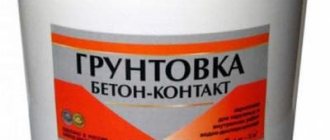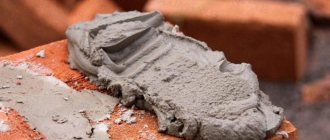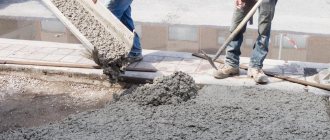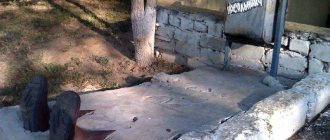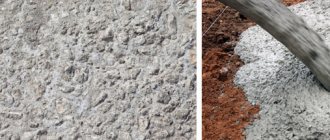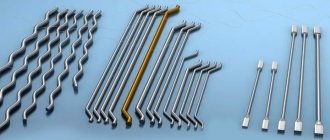Emulsols are concentrated water-miscible formulations that are used for:
- preparation of lubricating and cooling emulsions in the metalworking industry, working fluids for hydraulic systems of industrial and mining equipment, including powered mine supports;
- lubricating molds for casting reinforced concrete products, paving slabs, foam and aerated concrete products, construction formwork.
The scope of application of the emulsol depends on the composition and technical characteristics.
Calculation of flow and adhesion force
The average consumption of Emulsol is about 0.02 liters per 1 m2. However, more accurate indicators depend on indicators such as:
- Ambient temperature - if the weather is cold, the consumption of protective material will be greater.
- Density of the mass - if the mixture is made independently from a concentrate, then the denser its consistency, the more lubricant you will need.
- Equipment used. If a gun is used, the consumption will be minimal. When working with a roller, you will need more solution than if you used a brush.
If we talk about adhesion force, it is calculated by the formula:
S = Q * a * x
According to which:
Read also: Entertainment from MTS
- S represents the desired quantity, that is, the adhesion force;
- Q is the stiffness coefficient of the formwork itself, which ranges from 0.15 to 0.55.
- a denotes the adhesion stress.
- x is a measure of the total surface area that is in contact with the concrete.
If you slightly reduce the clutch power, the formwork will be removed much faster and more accurately. Therefore, when preparing the mixture, it is worth taking time and calculating the adhesion of the materials.
Price
The price of emulsol directly depends on the region of sales. It comes in large and small quantities, so everyone will find exactly the right amount of lubricant for themselves. For example, there are 200 liter barrels on sale.
The average price of such a barrel filled with a synthetic base from the manufacturer EKS_A is about 8,000 rubles. This is not much for large volumes. The barrel has a sealed design, which allows you to take out exactly as much as you need, and store the rest for the time interval specified in the instructions.
For those who want to use removable, reusable formwork, this is a great option. For small volumes of concreting, it is recommended to purchase a smaller volume. 1 liter formwork emulsol on sale Its price will be about 50-60 rubles per liter.
As a rule, in this way, a barrel volume equal to 200 liters, previously purchased at a price of up to 8 thousand rubles per liter, is sold. Thus, the cost of one liter is twice as high as compared to purchasing in large quantities.
For a small house with an area of 10 by 10 meters, when the formwork is raised to a height of 80 cm, a 20 liter canister will be sufficient. From the manufacturer EKS A, such a volume can be found at a cost of up to 1,500 rubles.
The cost is low, and even with large volumes it is feasible. At the same time, you should not buy concentrate in the hope of diluting it in half. Follow the instructions when preparing the emulsion, otherwise you risk that the quality of the solution will decrease. The formwork will not lag behind the concrete.
CONSUMPTION OF EMULSOL FOR FORMWORK AND WAYS TO REDUCE IT
The average consumption of emulsol for formwork is 0.02-0.03 l/m2, but it can vary significantly depending on the type of material and the position of the surfaces being treated, the method of application, and the ambient temperature.
| Material of formwork panels | Application on a horizontally inclined surface | Application on a vertical surface | ||
| Spray | Brush | Spray | Brush | |
| Summer time | ||||
| Plastic, steel | 300 | 350 | 400 | 430 |
| Wood | 320 | 350 | 350 | 420 |
| Winter time | ||||
| Plastic, steel | 300 | 400 | 350 | 400 |
| Wood | 300 | 400 | 300 | 350 |
The consumption of ready-to-use lubricant for a specific application method is indicated on the product packaging.
The consumption of emulsol per 1 m2 in diluted form depends on the concentration of the working solution: the lower it is, the less product is required to treat formwork panels. But we should not forget that the use of too liquid an emulsion leads to problems with stripping and damage to cast surfaces.
The number of components for preparing an emulsion with the necessary technical characteristics is calculated by the formula:
Rk = (K×Rv)/(100-K)
Rk and Rv
– weight of emulsol and water, respectively, kg;
TO
– required solution concentration, %.
You can reduce emulsol consumption without compromising the quality of concrete work if:
- apply it to assembled formwork structures;
- use sprayers with replaceable heads.
Lubricant requirements
Formwork release agent is used to solve a number of problems that arise in monolithic construction. Its main task is to ensure a smooth concrete surface and to be able to use the formwork repeatedly. Therefore, a number of the following requirements are imposed on lubricants:
- They should not leave oily stains or other marks on the surface of concrete as well as reinforced concrete products (concrete products). This can lead to peeling of the future finish, which will not have sufficient adhesion to the main one.
- Lubricants should not interact chemically with additives that are added to the concrete mixture to improve its characteristics.
- They must be kept on vertical surfaces without draining for at least 24 hours at a temperature of +30 °C.
- The lubricant composition must meet fire safety requirements.
- The composition must not contain substances hazardous to human health.
- The lubricant composition should ensure easy separation of formwork forms from reinforced concrete products and concrete structures.
- The operating temperature range must be large enough so that the material can be used at any time of the year.
Emulsol production: certificates, specifications and technical requirements
The main document defining the characteristics of the EKS-M emulsol is TU 0258-005-50689857-2013. Technical requirements for the liquid are regulated by:
- GOST 22386. Requirements for determining the acid number. The norm is 8-10 mg KOH/g.
- GOST 6243. Test method for determining the intensity of oil release. Standard - no more than 1% in 8 hours.
- GOST 2477. Determination of water content in a concentrated product. For EKS-M - no more than 2%.
The certificate received for the updated emulsol confirms the quality of the release agent. N-Petros LLC supplies lubricants for formwork with all the necessary documentation and preparation instructions. For more detailed information about technical fluids and to place an order, contact the plant manager.
CLASSIFICATION AND COMPOSITION OF EMULSOLS
In order to obtain high-quality reinforced concrete products, additives are introduced into emulsols for lubrication of molds and formwork to prevent the formation of air pores and cavities.
The composition and technical characteristics of a specific brand of emulsol are regulated by the relevant GOST or manufacturer's specifications, quality tests are carried out in accordance with GOST 6243-75, sampling is carried out in accordance with GOST 2517-2012.
EMULSOL FOR MOLD LUBRICANT - PREPARATION METHOD
The video shows a recipe for preparing a lubricant for paving slab molds, which is an analogue of EKS-A emulsol. You can use it if you are unable to purchase factory-made mold lubricant. However, before you engage in home-made production, we advise you to think about it, because:
- With the systematic use of homemade analogues, the quality of finished products and negative consequences for the health of workers (allergies, rashes, respiratory diseases) may deteriorate.
- The cost of the finished emulsol does not greatly exceed the cost of purchasing all the ingredients and the time spent on its preparation.
- The consumption of high-quality emulsion is lower, which means it is more economical, which further eliminates the difference in price.
Adhesion Reduction Methods
Strong adhesion of the solution to the walls of the molds makes it difficult to loosen them. This also deteriorates the quality of finished products and quickly destroys formwork structures. The degree of connection is influenced by:
- adhesion force between surfaces (adhesion);
- adhesion of particles inside cement (cohesion);
- shrinkage of concrete;
- roughness and porosity of forming planes.
At the time of laying, the concrete is in a plastic state, and after vibration compaction it comes as close as possible to the walls of the form. Preliminary lubrication of the formwork forms a thin film on it, which reduces the adhesion force. Concrete sticks least to plastic surfaces.
Types of lubricants
Protective agents are divided into four groups according to their composition, operating principle and technical parameters.
1. Suspension - aqueous solutions of powdery substances that do not adhere well to concrete. This is the simplest and most affordable way to eliminate sticking. Water-based formwork lubricant is prepared on the basis of gypsum, lime and sulfite-alcohol stillage (alkali).
2. Hydrophobizing - lubricants (emulsions) for formwork, made on the basis of mineral oils, emulsifiers or salts of fatty acids. The thin film formed on the forming shield serves as an excellent barrier to the penetration of moisture from the solution.
A significant disadvantage is that the oil layer remains on the surface of the products. This greatly pollutes and worsens their appearance. The high consumption of lubricant, combined with high cost and fire hazard, makes it little in demand.
3. Set retarder - a mixture that reduces the rate of hardening of concrete in a thin layer adjoining the walls of the formwork. Contains tannin, molasses and other substances. The disadvantage is the difficulty of determining the optimal thickness of the solution in which setting should slow down.
4. Combined - protective compounds endowed with the properties of forming surfaces while simultaneously slowing down the hardening of concrete in the joining layers. Lubricating emulsions are prepared on a fat basis with the addition of additives that enhance the plasticization of concrete and reduce its porosity.
Emulsol - a technically necessary solution
The retail chain offers mixtures to protect formwork panels from concrete adhesion. If desired, you can buy Tiralux-1721, Petramine, Angrol, Emulsol. The latter remedy is rightly considered the most popular and effective. It is a modern lubricant made on the basis of mineral oils with the addition of emulsifiers, anti-corrosion additives and other active components.
Emulsol for formwork looks like a transparent emulsion of yellow or light brown shades. After application to the surface, it turns into a thin oily film that protects the prefabricated structure from damage during dismantling. The uniqueness lies in the ability not to spread, but to be securely held along the walls of the formwork for the entire period of pouring and hardening of concrete.
Features of the mixture
In order for the constructed monolithic structure to be strong, reliable and durable, it is necessary to adhere to certain rules during the production process. The final result is influenced by the formwork material, the quality of the cement mortar, correctly selected components for the molding box and lubricant consumption.
The industry produces Emulsol in the form of a mixture, completely ready for use. You can buy several types of lubricant, specifically designed for certain jobs:
- EKS-ZhBI – has anti-corrosion properties and is used in the production of reinforced concrete products.
- EKS-IM – serves as reliable protection for expensive formwork panels and is distinguished by high performance characteristics.
- EKS-A - suitable for pouring any building structures that do not contain reinforcement joints.
The average lubricant consumption for formwork is 0.02 l/m2.
| Name | Barrel capacity l/kg | Price, rubles |
| EX-A | 216/186 | 7 000 – 10 800 |
| EX-IM | 216/186 | 7 000 – 9 050 |
| EX-REC | 216/186 | 7 650 – 10 000 |
| Petramine | 200/175 | 7 000 – 8 600 |
| Angrol | 216/186 | 6 000 – 8 000 |
How to carry out the work?
Before starting work, the emulsion must be mixed well, small containers can simply be shaken, large volumes should be mixed in stages in portions.
Finished concrete forms located near the work site must be covered with plastic film; the solution should not come into contact with them.
Spraying is carried out from a distance of 1 m until drops form on the material.
Using a roller, the liquid is distributed over the entire area; special attention should be paid to corners, edges, and places with defects.
In the most difficult to reach areas, you will have to apply the liquid with brushes, which will increase consumption, but will provide reliable protection.
How to use delimiters
Briefly about how to properly apply release agent. Typically, lubricant is applied with a brush. Even if you are the owner of a separator packaged in cans, all the same, after spraying the lubricant, it must be spread over the form with a brush
When applying lubricant, it is important to maintain the golden mean: you cannot use too little or too much of it. Two or three full passes of a thin brush over the entire contact surface will be sufficient
If you apply too little lubricant, there is a risk that your product will stick together during removal; if you apply too much lubricant, there will be a possibility that your casting material will react with the lubricant before it sets, which will also affect the quality of the final product.
Types of lubricant mixtures
All special solutions used for lubrication are divided into four types according to their technical characteristics and chemical characteristics.
Aqueous suspension
It is considered a cost-effective option. In addition, it is quite possible to prepare this formwork lubricant yourself. A liquid soap solution with kerosene, a mixture of clay and oil, and a suspension prepared from lime and gypsum diluted with lye are suitable. The compositions are mixed and applied to the formwork elements, which should then be dried. The thin layer remaining on the boards after drying is inert to the concrete solution. It happens that the decks of a structure are painted with a simple composition - diluted lime or cement laitance. Variants of such lubricants are inexpensive and are excellent for small formwork structures, the concreting of which involves the use of bayonet rather than vibration compaction. Formwork treated with such solutions should not be tapped. The fact is that the lubricating layer does not have elasticity, and after impacts from the shields it peels off, mixing with the solution in the contact zones, contaminating its surface and reducing its strength.
If concreting is carried out with vibration compaction, such pre-lubrication compounds are not used.
Water repellents
The price of these lubricant mixtures is quite high; not every one is considered safe for the solution in terms of contamination of the surface of the structure. Lubricant mixtures for formwork are in demand because their chemical composition contains surface-active components, the basis of which is mineralized oils.
Based on organic hydrocarbons – retarding
The retarders found in such mixtures quite effectively fulfill their purpose of separating the formwork surface and concrete mortar. However, they are used infrequently, because such lubricants have a side effect - sometimes it is difficult to control the slowdown process; the course of the reaction is influenced by numerous conditions, including air temperature. Due to the effects of such reactions, the surface of the foundation structure may be under stress and crack.
Combined
Such samples of lubricants are considered more profitable, and many builders are not stopped even by their high price. The composition includes retarders for the hardening of the concrete mass and water-repellent components, the negative impact of which is reduced by the addition of plasticizers. The main purpose of such emulsions is to make the surface of the foundation structure smooth and ensure easy dismantling of formwork panels.
Inverse emulsions have certain properties - they reduce the number and parameters of pores, and somewhat increase the resistance of concrete to moisture.
What is
Formwork lubricant Emulsol is a water repellent made from the following components:
- Mineral oils (60-80% of the total volume) are the basis of the composition.
- Surfactants are soap-like surfactants that are used as emulsifiers and stabilizers. Their volume is about 20-40%.
Additionally, alcohol, polyethylene glycol, bactericides and other additives are sometimes added to mixtures for lubricating molds.
The light yellow or brown emulsion is easily applied to the surface of the formwork structure, forming a thin oily film on its panels. In this case, the liquid does not spread and remains securely on horizontal and vertical surfaces throughout the entire period of hardening of the concrete structure. Thanks to this, the poured concrete solution does not lose moisture and does not adhere to the formwork.
Emulsol is a composition that is often used to process materials that have high adhesive properties (more than 0.03 MPa). For formwork panels made of wood or sheet metal, this figure is 0.18 MPa.
However, despite its many advantages, Emulsol lubricant has several disadvantages:
- The oily film leaves greasy marks on the concrete.
- Lubricant consumption is higher when compared with cheaper compounds.
- The cost of the composition is slightly higher when compared with other analogues.
How to choose an emulsol
In metalworking
When choosing a cutting fluid for cutting metals, consider the following:
- Type of equipment;
- speed mode;
- tool used;
- operation;
- workpiece material;
- emulsion delivery method.
Metalworking cutting fluid provides wear resistance, corrosion resistance, and improves the quality of the workpiece.
In construction
The choice of construction emulsol is influenced by several factors:
- Operating temperature – it is taken into account that in the cold the viscosity and consumption of lubricant increases.
- Position of the workpiece: the plane being processed can be located horizontally, vertically or have a slight slope. Typically, the closer the plane being processed is to the vertical, the more viscous the lubricant should be.
- Material of formwork or product. The formwork can be steel, wood, laminated plywood, etc. The material of the product is concrete, gypsum, foam concrete, etc. For example, steel forms are treated with a lubricant with an anti-corrosion additive.
All technical characteristics must be selected taking into account these factors.
Why are they needed and where are they used?
Monolithic construction
Monolithic construction is becoming more and more popular.
With the advent of modern technology, the construction process is undergoing great changes. Thanks to the advent of special structures - wall formwork
and
floor formwork
it became possible to quickly erect monolithic buildings
.
Such structures are made from steel, aluminum and plastic.
They can be either fixed or removable. The first ones are not removed after pouring with cement, remaining part of the structure. The second ones must be removed after the cement hardens. Removable formwork is reusable. And to extend its service life, there is a special lubricant for formwork - formwork oil .
The most common lubricants are formwork lubricant Angrol
,
various types of Emulsols, including Petramine.
A lubricant that extends the life of formwork.
One of the most effective lubricants for formwork is Emulsol. This is a modern lubricating emulsion consisting of mineral oils, emulsifiers, anti-corrosion and various active substances. It has a transparent yellow or light brown color. After applying the lubricant, a thin oil film forms on the walls. With the help of this film, the wall formwork is protected from damage during its dismantling. Due to the fact that the lubricant has special physical and chemical properties, it does not spread over the surface of the molds. On the contrary, the lubricant remains on the formwork walls throughout the entire period of concrete pouring and drying. Concreting floors using formwork using lubricant is much easier. In addition, the erected walls of a building in such conditions are characterized by greater strength, durability and solidity.
Formwork lubricant
Emulsol has several varieties.
It must be used only for its intended purpose. Otherwise, the lubricant will not perform its function either in relation to the formwork or in relation to the structures being poured. buy emulsol
from us at reasonable prices.
How to use formwork release agent correctly
For the production of reinforced concrete products on construction sites, formwork should not be used without special lubricant. Metal parts of the formwork that are not protected by lubricant are subject to corrosion, and plywood is destroyed by rotting due to moisture ingress. However, in order for the formwork to be well preserved, the lubricant must be of high quality. Poor quality lubricant can lead to the mixture sticking to the mold and poor separation of the mold from the poured surface. As well as the appearance of stains and cracks on the walls of the building, the release of an unpleasant odor from the product. The strength of the structure being built is influenced by many factors: the quality of the formwork, the quality of the concrete, and correctly selected components for the formwork. The quality of the lubricant is also not in last place. However, all the shortcomings appear only after concreting is completed. Therefore, all possible flaws should be foreseen in advance and prevented. There are the following types of Emulsol lubricant: - emulsol EKS-ZhBI
– used in the production of concrete products, does not require dilution;
— EX-IM emulsol
– well suited for expensive removable formwork;
— emulsol EKS-A
— in addition to the production of reinforced concrete products, it is used on the construction site. High-quality and inexpensive lubricant for formwork of the “Emulsol” brand is especially in demand in the construction of monolithic structures. She “gently” takes care of the formwork and the structure being built. Using waste oil or diesel fuel as a lubricant can greatly harm the structure and shapes.
In our company in Moscow you can also buy formwork lubricants such as Emulsol , and such as Petramine and Angrol.
Hazard classes of emulsol for humans and the environment
In accordance with GOST 12.1.007-76, the hazard class of emulsol for humans is determined by the component that has the most harmful effect on the body.
The maximum permissible concentration (MPC) of harmful substances in the air of the working area and their hazard classes are regulated by GOST 12.1.005.
The most popular emulsol in our country, EKS-A, belongs to hazard class III, but it is being replaced by less toxic compounds (for example, OILCOOL FORM lubricant for molds and formwork structures has hazard class IV).
During the use of emulsol, thermal destruction of its components is possible, which leads to an increase in the hazard class.
Basic safety precautions when working with emulsols:
- the use of production technologies that exclude personnel contact with harmful substances;
- use of personal protective equipment (working clothing, respirators, goggles), compliance with hygiene rules;
- ensuring proper ventilation of production premises, industrial cleanliness in accordance with the requirements of GOST R 50558-93;
- organization of air control in work areas in accordance with GOST 12.1.005-88.
The calculation of emissions of harmful substances into the atmosphere is carried out according to GOST 32602-2014, and their maximum permissible values are regulated by GOST 17.2.3.02-2014.
The hazard class of used emulsols depends on the content of oil or petroleum products: with an amount of up to 15%, the waste belongs to hazard class IV, and over 15% – to III.
Advantages when compared with analogues
The lubricant is in demand among consumers, which is fully explained by its tangible advantages.
- Aqueous suspensions, naturally, are cheaper, but water has a high penetrating ability, and as a result, the resulting layer does not perform a protective function. Therefore, dismantling while maintaining the quality of the formwork panels and concrete base will require a lot of effort and time, and the result will still not be pleasing.
- Commercially available organic inhibitors that reduce the setting speed of concrete are applied to the surface in a layer of varying thickness. As a result, in some places the concrete thickens and sticks quickly, while in others it is still in the form of a viscous mass.
- There are high-quality products consisting of substances that slow down the hardening of concrete, reduce its porosity, and increase its hydrophobic properties. Such products are called reverse action emulsions. They demonstrate good qualities, but are expensive, so suppliers rarely offer these solutions.
Emulsol is an excellent composite solution that can significantly reduce the adhesion of concrete mixtures. The liquid has a reasonable price and is offered for sale in an assortment.
Composition modifications
In construction practice, one has to deal with materials and structures with different properties and application features. In accordance with needs, manufacturers produce several varieties of the product.
- EKS reinforced concrete products are adapted for contact with metal alloys and prevent their oxidation due to the presence of anti-corrosion additives.
- EKS IM is intended for the production of reusable formwork; the product has particularly high durability, therefore it is characterized by a considerable price.
- EKS M is adapted for washing matrices necessary for the production of forms from foamed concrete.
- Petramine - 7-05 is able to protect formwork made from both wooden and plastic elements. The liquid simplifies the production of shaped concrete forms in harsh climatic conditions and is used in the construction of bridges and tunnels.
- EKS-AElit is recommended for coating materials that must look impeccable and also have particularly high strength.
- EKS A is a product for universal use in the manufacture of various concrete bases that do not have reinforcing elements.
The latter type of lubricant can be used in almost any circumstances, the main thing is that the manufacturer is guided by the mandatory regulatory document - TU 0258-004-27192068-2002.
It is important to note that Emulsol cannot be used to coat white concrete forms due to its inherent color. In such cases, buy colorless compositions, for example AGATE-C5 or AGATE-BIO.
Lubricant consumption
A good result can be obtained with proper processing and calculation of the required quantity. Theoretically, on average, 20 ml of liquid is needed for every square meter of area; in this case the layer thickness will be 0.3 mm. Such a small volume will create reliable protection on high quality materials when applied with efficient spray devices.
To accurately calculate the required quantity, it is important to consider the following indicators:
- properties of the processed material;
- ambient temperature;
- solution viscosity;
- application technology.
Most manufacturers indicate consumption for various materials, application methods and application conditions in the accompanying documents.
As practice shows, more lubrication will be needed in the following situations:
- in winter compared to the warm summer season;
- when applied with a brush than when sprayed from a gun;
- when covering a vertical plane than when lubricating a horizontal surface.
The expected consumption should be determined in advance, and consultation should be obtained if necessary. At DAKSpol, depending on the required volumes, you can buy consumables for lubricating formwork in small containers with a volume of 15 liters or more or in large barrels with a volume of 200 liters. If the customer has a need for a large amount of Emulsol, shipment to the customer’s tanks can be ordered.
Features of applying and preparing lubricant
The cheapest way is to prepare the required solution from Emulsol concentrate. To do this, at the first stage you need:
- Take 1 part of the concentrate and 2 parts of warm water with soda ash diluted in it.
- Pour the components into a container (for example, a plastic bottle). First, Emulsol is poured in, then a little water is added to it, the liquid is thoroughly shaken and mixed. After this, add a little more water and mix everything again until smooth.
- When the lubricant turns into a mayonnaise-like liquid, pour it into a spray bottle (if you plan to apply the solution manually, any container will do).
- We lubricate the surface of the formwork with it and wait until the solution dries.
After the mixture has stopped flowing down when the formwork moves, you can begin pouring concrete and then pouring it with bitumen emulsion.
However, despite the fact that the composition of the emulsion does not pose a biological hazard, it is worth considering one more important nuance - during the work it is necessary to follow precautionary measures, namely:
- work in protective clothing;
- do not spray lubricant near large crowds of people;
- Follow the solution manufacturer's recommendations.
It is also not recommended to use cheap lubricants that are not produced according to technical regulations.
How does Emulsol differ from other formulations?
Despite the fact that Emulsol has quite significant disadvantages, it still remains one of the most popular formulations. This is explained by the fact that other anti-adhesive mixtures cannot provide adequate protection for wooden or metal formwork panels:
- Water-based suspensions are low cost, however, such hard solutions stick to the surface of the monolith and you have to spend a lot of time cleaning the finished concrete bases.
- Set retarders made from organic carbohydrates are characterized by their instability. When using such mixtures, concrete begins to set unevenly.
- Combined lubricants (or, as they are also called, reverse emulsions). Such products contain water repellents, hardening retarders and components that reduce the porosity of concrete. However, such formulations are expensive and very difficult to find on sale.
Thus, the use of Emulsol is the optimal choice for processing formwork structures. Today there are quite a few suppliers on the market that offer consumers various types of lubricating emulsions.
How to prevent bubbles
The lubricant mixture can not only make removal from the sample simple, but also prevent bubbles. If you have already been interested in the tile production process, then you know that hardened concrete sometimes has bubbles. They appear on the front side of the paving stones and look untidy.
By using one little secret, you can avoid this unpleasant phenomenon: add a plasticizer to the lubricant composition, and there will be no bubbles.
The quality of the tiles also depends on the cement. Purchase this material from reliable and trusted construction stores.
If you need colored tiles, then dilute the dyes in advance and preferably let them sit for half a day: don’t worry, the solution will not deteriorate or become deformed.
When is coolant replacement required?
The emulsol is replaced after the expiration date of the product, as well as in cases where its quality, appearance and performance characteristics have significantly deteriorated during use.
As practice shows, oil emulsols have a longer shelf life compared to water-based cutting fluids. This is explained by the fact that water is a good environment for the development of all kinds of microorganisms, which leads to a decrease in pH levels and the appearance of an unpleasant odor. Harmful factors for water-miscible coolants are also elevated temperatures, contamination with lubricants and abrasives. Such an emulsion loses stability and its properties and becomes more toxic. Current monitoring of the coolant condition makes it possible to promptly identify inconsistencies and make adjustments. The frequency of monitoring is established by the standards:
- for oil coolants: once a month
- for semi-synthetic and synthetic coolants: once every 2 weeks
- for emulsion coolants: once a week
Do-it-yourself paving slabs: the manufacturing process at home
To reduce the cost of manufacturing paving slabs, it is recommended to carry out this procedure yourself. In order to make high-quality tiles, it is recommended to use the vibration casting method. This will ensure a dense structure of the concrete mixture, which will have a positive effect on the quality of the tiles and their service life.
Step-by-step description of the process at home
At the initial stage, you need to prepare all the tools and materials. The work is carried out using:
- Concrete mixers.
- Vibrating table.
- Racks for storing molds.
Warm water is collected in the container. They are necessary for removing finished products from molds. You also need to take care of purchasing or making the molds themselves.
At the preparatory stage, a person must prepare a solution from ½ part sand, 1/5 cement, ¼ granotsev, 1/100 plasticizer, 7/100 dye, 1/20 water. All components are placed in a concrete mixer and mixed thoroughly. The plasticizer is first dissolved in a small amount of water. Sand is added to the mixture, and at the final stage - cement. In order to effectively mix the composition, you need to periodically add water to the concrete mixer.
The following is a step-by-step implementation of the work:
- Initially, the forms are prepared. If new devices are used, then no work is performed at this stage. Old molds that have already been used must be cleaned.
- Before pouring the concrete mixture, the surface of the molds is lubricated with the selected composition.
- At the next stage, the prepared concrete of the required consistency is poured into molds.
- Molds with concrete should be shaken slightly and placed on a vibrating table. When a white film appears on the surface, the molds are removed. If two-color paving stones are made, then compaction of each layer is carried out separately.
- The molds are placed on the surface until the solution dries completely. To avoid cracking of the concrete mixture, it is recommended to periodically spray the surface with water.
At the final stage, you need to pull the finished tiles out of the molds. To do this, the tile along with the mold is lowered into a container of water, the temperature of which is 60 degrees. Due to the effect of heat on the mold, it expands, which will facilitate the process of drawing out the tiles.
DIY mold lubricant
You can lubricate paving slab molds at home using a mixture that you prepare yourself.
In order to prepare the composition, you need to take liquid soap and dissolve it with water in a ratio of 1:3.
When making tiles, it is allowed to use a lubricant based on machine oil. This product is mixed with water in a ratio of 1:5. The proportion is determined depending on the desired density of the final material. In order for the composition to be homogeneous, it is mixed using a high-speed mixture or emulsion.
Saline solution is also used to lubricate molds. Its universal composition eliminates the possibility of the composition sticking to the form. You need to dissolve 1 pack of table salt in a bucket of water. In order for the liquid to completely dissolve, it is heated. But, only a cold solution should be used for application to the surface.
How to lubricate?
The method of applying the lubricant directly depends on its consistency. Liquid aqueous mineral compositions are applied using a sprayer. You can simply dip the molds in grease. The oil is applied using a brush or foam sponge.
During the period of work, you need to ensure that the inner surface of the mold is completely covered with the composition. That is why the molds are greased 2 times at a 20-minute interval. This will ensure even distribution of the composition. It will completely cover the surface of the mold. Before applying the mixture, the molds are cleaned and dried thoroughly.
If a homemade composition is used, then a test is first made on 1-2 tiles. If the quality is satisfactory, then this technology is used for the production of tiles.

